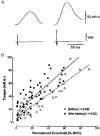Changes in single motor unit behaviour contribute to the increase in contraction speed after dynamic training in humans
- PMID: 9782179
- PMCID: PMC2231276
- DOI: 10.1111/j.1469-7793.1998.295by.x
Changes in single motor unit behaviour contribute to the increase in contraction speed after dynamic training in humans
Abstract
1. The adaptations of the ankle dorsiflexor muscles and the behaviour of single motor units in the tibialis anterior in response to 12 weeks of dynamic training were studied in five human subjects. In each training session ten series of ten fast dorsiflexions were performed 5 days a week, against a load of 30-40% of the maximal muscle strength. 2. Training led to an enhancement of maximal voluntary muscle contraction (MVC) and the speed of voluntary ballistic contraction. This last enhancement was mainly related to neural adaptations since the time course of the muscle twitch induced by electrical stimulation remained unaffected. 3. The motor unit torque, recorded by the spike-triggered averaging method, increased without any change in its time to peak. The orderly motor unit recruitment (size principle) was preserved during slow ramp contraction after training but the units were activated earlier and had a greater maximal firing frequency during voluntary ballistic contractions. In addition, the high frequency firing rate observed at the onset of the contractions was maintained during the subsequent spikes after training. 4. Dynamic training induced brief (2-5 ms) motor unit interspike intervals, or 'doublets'. These doublets appeared to be different from the closely spaced (+/-10 ms) discharges usually observed at the onset of the ballistic contractions. Motor units with different recruitment thresholds showed doublet discharges and the percentage of the sample of units firing doublets was increased by training from 5.2 to 32.7%. The presence of these discharges was observed not only at the onset of the series of spikes but also later in the electromyographic (EMG) burst. 5. It is likely that earlier motor unit activation, extra doublets and enhanced maximal firing rate contribute to the increase in the speed of voluntary muscle contraction after dynamic training.
Figures






References
-
- Behm DG, Sale DG. Intended rather than actual movement velocity determines velocity-specific training response. Journal of Applied Physiology. 1993;74:359–368. 10.1063/1.354117. - DOI - PubMed
Publication types
MeSH terms
LinkOut - more resources
Full Text Sources
Medical

